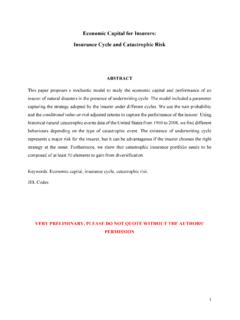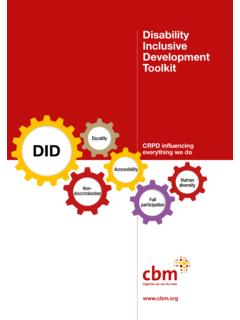Transcription of MARKET IMPLICATIONS OF PUBLIC POLICY INTERVENTIONS: …
1 1 MARKET IMPLICATIONS OF PUBLIC POLICY INTERVENTIONS: THE CASE OF FLORIDA S PROPERTY insurance MARKET Lorilee A. Medders* Charles M. Nyce J. Bradley Karl Florida Catastrophic Storm Risk Management Center College of Business, Room 112 RBB Florida State University Tallahassee, FL 32306-1110 *Phone: 850-645-8393 Fax: 850-645-8391 The authors wish to thank Patrick F. Maroney and Sue Ellen Smith for their valuable contributions to this article. Last updated: March 2, 20122 MARKET IMPLICATIONS OF PUBLIC POLICY INTERVENTIONS: THE CASE OF FLORIDA S PROPERTY insurance MARKET Abstract This article asserts that the MARKET for property insurance , particularly homeowners insurance , in the State of Florida currently is experiencing a number of failures, and that a combination of MARKET problems, externalities and interventions unique to Florida led to these failures.
2 The authors provide a narrative description of the MARKET events, problems and policies preceding the MARKET failures and present data that evidence the MARKET failures. Recommendations for a return to risk-based pricing and incentives for appropriate mitigation are made. Introduction Florida s heavy geographic exposure to catastrophic tropical windstorms is clear, but this single MARKET factor is only one of myriad factors that impact Florida s MARKET . The availability of private capital to support catastrophic windstorm exposure is contingent upon regulatory and legislative directives intended to ease MARKET pressures and stabilize pricing. We submit that recent government interventions in the state s property insurance MARKET have suppressed prices and increased long-term state MARKET pressures that create questions of MARKET sustainability.
3 The paper consists of four sections. Section 1 contains a discussion of the prior literature relevant to insurance MARKET problems, capacity constraints, MARKET performance and their relationship to government interventions. Section 2 describes the structure of Florida s homeowners insurance MARKET as well as its current condition, and compares Florida s MARKET with markets in other states. Section 3 examines specific MARKET problems in Florida and negative externalities created by government responses to these problems that the authors assert all have contributed to the MARKET s present condition. Section 4 offers concluding thoughts and avenues of future research. 3 Risky insurance Markets, Capacity Constraints and Government Interventions Prior research into the nature of insurance MARKET capacity and its relationship to MARKET performance and MARKET interventions is abundant.
4 What follows is a discussion of the existing relevant literature. Problems in High-Risk (Catastrophe) insurance Markets Both on the demand and supply side, insurance markets experience a number of well-known difficulties, from seller-buyer informational problems to seller constraints on capacity. Markets that include high potential for catastrophic industry losses especially are subject to these problems. Thus, the relationships between demand-supply efficiencies, resulting MARKET performance and aggregate MARKET capacity are important in the study of catastrophe-exposed markets. Arrow (1971) and Dionne and Harrington (1992) describe basic models for insurance demand by individuals, and Kunreuther (1998) describes the special effects of catastrophic risk on these models.
5 Several studies, such as Ehrlich and Becker (1972), Kunreuther (1978), Dionne and Eeckhoudt (1985), Hiebert (1989), Kunreuther and Kleffner (1992), Kunreuther (1996) and Kleffner and Kelly (2001), have established the individual insurance purchase in the face of disaster potential as being, to some extent, a choice between loss mitigation (self- insurance ) and risk transfer ( insurance ).1 Additional research has found evidence of an inverse relationship between expectations of government disaster relief and both structural mitigation and insurance demand. The findings of Kaplow (1991), Kelly and Kleffner (2003) and Kunreuther and Pauly 1 The findings of research regarding the actual relationship between the availability/pricing of insurance and personal investments in risk-reducing activities are mixed; while insurance transfers risk of financial loss from the individual to the insurance company it inherently creates an incentive for insurance companies to develop a pricing scheme that rewards policyholders who mitigate.
6 So while the availability of insurance reduces the incentive to make mitigation expenditures, all else the same, insurance prices can be adequately high to encourage mitigation. See Kleindorfer and Klein (2003) for mathematical illustration and additional literature pertaining to the relationship between insurance and mitigation. 4 (2006) are consistent with the idea that disaster assistance reduces incentives for individuals to invest in risk reduction or private risk transfer. The literature on supply-side problems in markets shows us that solvency constraints limit the available capacity of the Herring and Vankudre (1987) and Greenwald and Stiglitz (1990) contend that insurers may view solvency concerns in light of the transactions costs of insolvency and the franchise value of the firm as a going concern.
7 Klein and Kleindorfer (2003) extend the model to the case of markets with industry-wide disaster potential, such as the Florida property insurance MARKET . Stone (1973) and Cummins, Doherty and Lo (2002) find that MARKET insurance capacity is at a maximum when there is either one monopolistic insurer or when all insurers participate in some proportion of every risk. Segmentation by line therefore reduces MARKET capacity. Furthermore, capacity for catastrophic insurance will increase if: there is a shift toward greater risk bearing; data related to catastrophes improves; catastrophic insurance rates increase; or segmentation is reduced. Doherty (1980) develops a model wherein capital MARKET structure determines capacity, and specifically MARKET capacity differs with choice of reinsurance.
8 Doherty (1983) builds on this capital structure theory to model capacity as a measure of the risk-return performance of an insurer s asset-liability portfolio. MARKET capacity, in all of these models, is the aggregation of capacity of all individual firms in the MARKET . Nielson (1984) analyzes the interrelationships among surplus, investment risk, underwriting risk and expenses with regard to how they relate to capacity. Nielson (1984) expresses the capacity of the insurance industry as a relationship between policyholders surplus, investment risk, total assets, rate of return, underwriting expenses and insurer-specific capital needs and premiums. 2 Stone (1973) and Herring and Vankudre (1987), followed by Grace, Klein and Kleindorfer (1999) lay out the capacity issues faced by insurers when considering risk-taking in problematic markets.
9 5 Prior literature pertaining to the underwriting cycle offers insight into factors that impact insurance availability as well. Gron (1994) evaluates the validity of arbitrage theory and the capacity constraint hypothesis as explanations for the underwriting cycle and finds support for the capacity constraint hypothesis. Gron (1994) finds evidence of a negative relationship between fluctuations in insurer capacity and insurer profitability. Gron (1994) also points out that guarantee fund associations may exacerbate capacity crises by reducing solvent insurers net worth through assessments. Doherty and Garven (1995) extend Gron s (1994) work to include the impact of interest rates on underwriting profits, with findings that suggest a relationship exists between insurer capacity and asset-liability management.
10 Government Intervention and MARKET Performance A variety of studies have analyzed the relationship between legislative-regulatory intervention and MARKET performance. Building on the prior work of Stigler (1971), Herring and Vankudre (1987), Greenwald and Stiglitz (1990) and Klein (1998), Klein and Kleindorfer (2003) develop a theoretical illustration of the negative externalities, and ultimately MARKET failures, that can result from decreases in the price ceiling within catastrophe-prone markets. Grace and Klein (2009) likewise provide further descriptive evidence of the impact of government choices on catastrophe markets. The choice by private insurers to decrease MARKET exposure, and thus decrease capacity in the highest-risk zones, as a result of interventions is of particular interest to this 3 Meier (1991) asserts the goals of insurance regulation should be viewed, not solely in terms of alleviating MARKET problems or correcting MARKET failures, but also as partially a function of political externalities.






